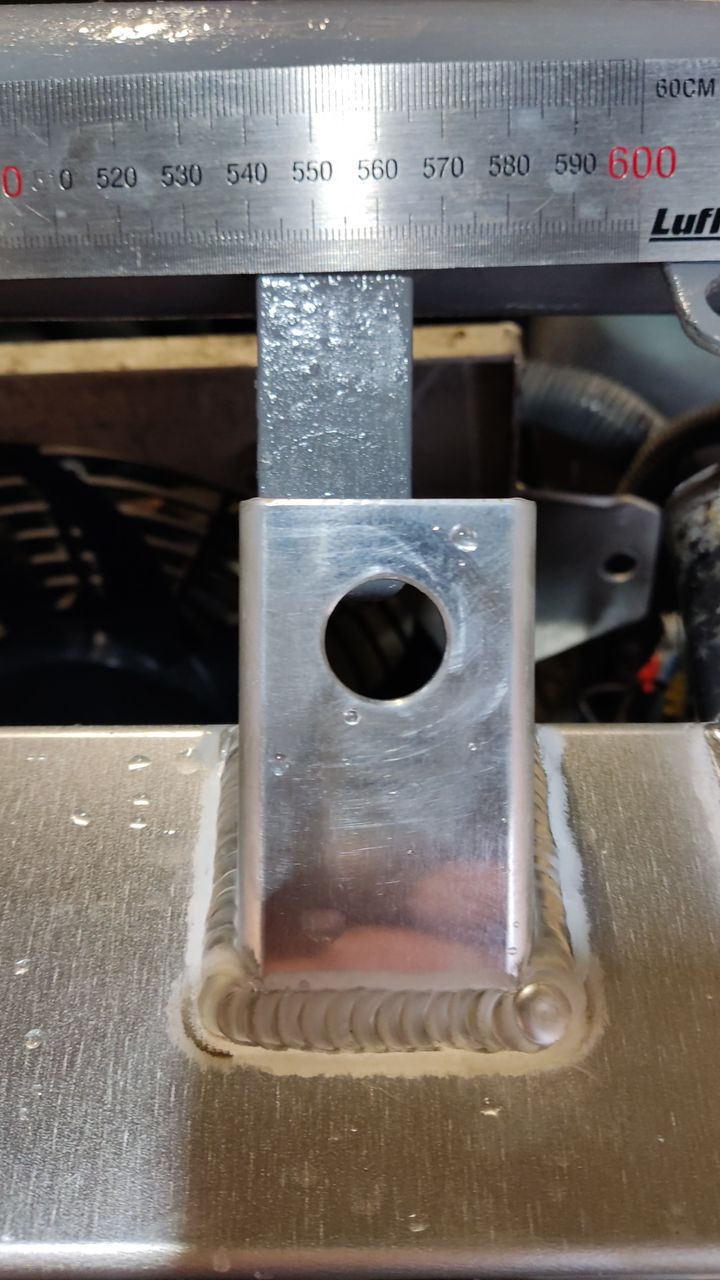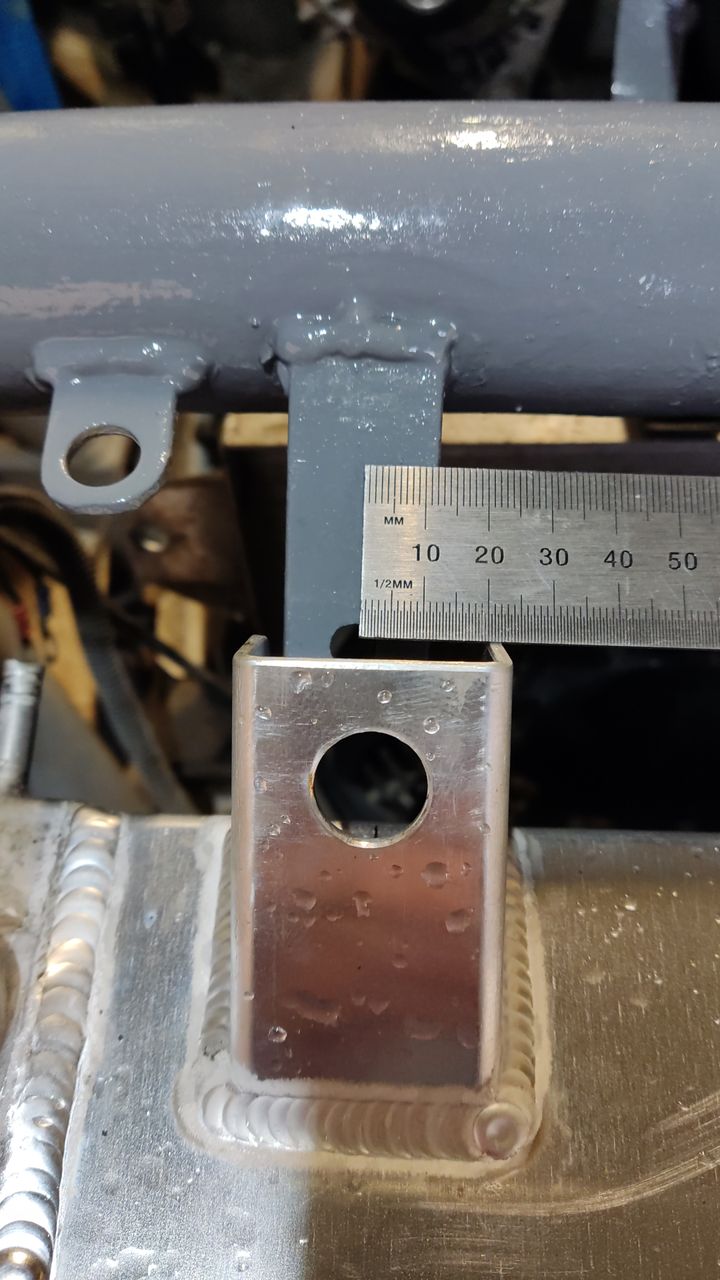Leaking aluminium radiator
Discussion
The radiator on my car developed an odd intermittent leak, here pictured when the system was pressurized by a bicycle pump to a few PSI.
The radiator is aluminium and mounted on four rubber grommets (two top / bottom) of the same type used on Classic Range Rover / Defender / Discovery, the radiator is about ten years old.
It looks like the welding between the matrix end plate and the end tank didn't penetrate very well or have I missed something?

Options are repair or replace.
What would you PHers do?
The radiator is aluminium and mounted on four rubber grommets (two top / bottom) of the same type used on Classic Range Rover / Defender / Discovery, the radiator is about ten years old.
It looks like the welding between the matrix end plate and the end tank didn't penetrate very well or have I missed something?

Options are repair or replace.
What would you PHers do?
Looks like it has split along the weld line, as you say. May be a poor weld, but it could also be a fatigue failure. It might be repairable by a good welder, but debatable whether it's worth the money if you're paying commercial rates. But if you are / know a decent welder you have nothing to lose by trying at this point.
Thank you.
I asked the manufacturer what they thought the cause of the leak was, they didn't comment besides mentioning coolant quality and ensuring the grounds were good to prevent electrlytic corrosion. The radiator is electrically isolated from the LV vehicle systems and the chassis with the only conductive path would be the coolant.
I asked the manufacturer what they thought the cause of the leak was, they didn't comment besides mentioning coolant quality and ensuring the grounds were good to prevent electrlytic corrosion. The radiator is electrically isolated from the LV vehicle systems and the chassis with the only conductive path would be the coolant.
Get it repaired, then test to rather higher pressure! Say 20psi?
If you live near Preston I recommend https://www.mrsheattransfer.com/.
Otherwise, anywhere that does aluminium welding.
John
If you live near Preston I recommend https://www.mrsheattransfer.com/.
Otherwise, anywhere that does aluminium welding.
John
I normally go for repair, repair, repair - even when beyond "economic" repair - but in this instance I would price up a new one. That weld has failed, have all the other welds started to fail, but are not leaking yet, by the time you have it out you would have done all the work to "just" drop a new one in.
Jaz2000 said:
I have a similar radiator problem and wondered if I could silver solder it to repair it.
Has anyone tried this or have more experience with silver solder than me.
Not tried it, but apparently it can be done if you use the appropriate solder and flux. I've seen an aluminium braising technique that looked very effective too. I suspect that contamination will be the biggest problem with all these approaches.Has anyone tried this or have more experience with silver solder than me.
Some of the "cold weld", which isn't a weld but a braze would work too.
That said, how much heat you need to put into the core with a torch for that...not sure. If the core itself has been welded, shouldn't be a problem. But some are epoxied etc, and in that case, not a good idea.
Either way, that is an easy for for most radiator repair places, or go for a full re-core as in this case. Although probably not necessary.
I'd have just welded it and then pressure test.
That said, how much heat you need to put into the core with a torch for that...not sure. If the core itself has been welded, shouldn't be a problem. But some are epoxied etc, and in that case, not a good idea.
Either way, that is an easy for for most radiator repair places, or go for a full re-core as in this case. Although probably not necessary.
I'd have just welded it and then pressure test.
stevieturbo said:
Some of the "cold weld", which isn't a weld but a braze would work too.
That said, how much heat you need to put into the core with a torch for that...not sure. If the core itself has been welded, shouldn't be a problem. But some are epoxied etc, and in that case, not a good idea.
Either way, that is an easy for for most radiator repair places, or go for a full re-core as in this case. Although probably not necessary.
I'd have just welded it and then pressure test.
As above, just get it re-welded.That said, how much heat you need to put into the core with a torch for that...not sure. If the core itself has been welded, shouldn't be a problem. But some are epoxied etc, and in that case, not a good idea.
Either way, that is an easy for for most radiator repair places, or go for a full re-core as in this case. Although probably not necessary.
I'd have just welded it and then pressure test.
Very excited to take delivery of the repaired radiator today despite my wallet being £440 lighter. It's had a replacement core welded in and arrived well packaged inside bubble wrap and cardboard (rather than the custom wooden crate I shipped it to the manufacturer in). Needless to say that the outer cardboard was damaged but the radiator was fortunately intact. No "fragile" markings on the packaging, not that they are heeded but it's the thought that counts.
I set about installing the repaired part this evening hoping to test-drive the car later but fount that while the bottom mounting pegs line up with the rubber bushed holes, the upper ones do not.
Is it unreasonable to expect that as part of the repair and QC process (there's a QC sticker on the bottom) that the location of the original mounting lugs is measured, recorded and reproduced when repaired?
The photos illustrate better, far from what a colleague used to call "excellent best".
What should my next step be - send the photos and ask how they'd like to rectify?
LH mount

RH mount

I set about installing the repaired part this evening hoping to test-drive the car later but fount that while the bottom mounting pegs line up with the rubber bushed holes, the upper ones do not.
Is it unreasonable to expect that as part of the repair and QC process (there's a QC sticker on the bottom) that the location of the original mounting lugs is measured, recorded and reproduced when repaired?
The photos illustrate better, far from what a colleague used to call "excellent best".
What should my next step be - send the photos and ask how they'd like to rectify?
LH mount
RH mount
Not near enough really.
This was the reply:
"Sorry to hear you are having trouble fitting this repaired radiator. Our jig which we have used for many years to make these radiators for "customer x" calls for the upper brackets to be placed at 510mm centre to centre."
No apology or admission of responsibility.
My lugs were at 506 centres but I'd used the radiator as a template and the holes were centred. I think the one radiator lug is misplaced and with the 510 centeres the failure to alignm results.
Very irritated.
I've cut the old lugs off and am part way through getting the replacement ready to weld on.
This was the reply:
"Sorry to hear you are having trouble fitting this repaired radiator. Our jig which we have used for many years to make these radiators for "customer x" calls for the upper brackets to be placed at 510mm centre to centre."
No apology or admission of responsibility.
My lugs were at 506 centres but I'd used the radiator as a template and the holes were centred. I think the one radiator lug is misplaced and with the 510 centeres the failure to alignm results.
Very irritated.
I've cut the old lugs off and am part way through getting the replacement ready to weld on.
Gassing Station | Engines & Drivetrain | Top of Page | What's New | My Stuff



